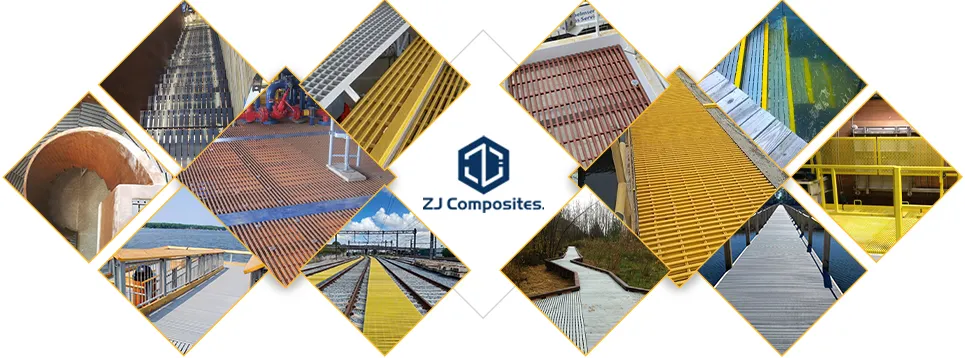loading...
- No. 9, Xingyuan South Street, Dongwaihuan Road, Zaoqiang County, Hengshui, Hebei, China
- admin@zjcomposites.com
- +86 15097380338
- Welcome to visit our website!
Composite FRP Grating Solutions for Enhanced Walkway Safety and Durability
The Advantages of Walkway FRP Grating
In recent years, the use of Fiber Reinforced Plastic (FRP) grating has surged across various industries, particularly in the construction of walkways. FRP grating is a composite material made from a combination of fiberglass and resin, which offers a multitude of benefits over traditional materials like steel or wood. This article delves into the many advantages of using walkway FRP grating, making it an ideal choice for both commercial and industrial applications.
1. Superior Strength-to-Weight Ratio
One of the primary advantages of FRP grating is its impressive strength-to-weight ratio. This means that FRP gratings are significantly lighter than steel counterparts yet can support similar loads. This weight advantage simplifies installation, reduces transport costs, and decreases labor expenses since fewer workers are needed for handling and installation. Consequently, projects involving FRP grating can be completed more efficiently and economically.
2. Corrosion Resistance
Unlike traditional materials, FRP grating is inherently resistant to corrosion. This characteristic makes it an excellent choice for environments exposed to moisture, chemicals, and saline conditions, such as coastal areas and chemical processing plants. While steel grating may degrade or rust over time, FRP grating maintains its structural integrity and aesthetic appeal longer, ultimately leading to reduced maintenance costs and increased service life.
3. Slip Resistance and Safety
Safety is paramount in any walkway design. The slip-resistant surfaces of FRP grating enhance grip, making it a safer option for walkways, especially in wet or hazardous conditions. With the growing emphasis on workplace safety, using FRP grating can help mitigate the risk of accidents, which is essential for protecting both workers and visitors in industrial settings.
walkway frp grating

4. Customizability
FRP grating can be easily customized to meet specific project requirements. Available in various colors, shapes, and sizes, it allows architects and engineers to create unique walkway designs that can blend seamlessly with the surrounding environment. Furthermore, FRP grating can be manufactured with different mesh configurations, providing options for varying load-bearing capabilities and aesthetic preferences.
5. Environmental Benefits
As the world moves towards more sustainable practices, the environmental benefits of using FRP grating cannot be overlooked. FRP materials are often made from recycled fibers and resins, which reduces the environmental impact during production. Additionally, FRP does not leach harmful substances into the environment, making it a safer choice for ecologically sensitive applications.
6. Long-Term Cost Savings
While the initial investment in FRP grating may be higher compared to traditional materials, the long-term cost savings are substantial. With lower maintenance requirements, extended lifespan, and reduced installation time, businesses can enjoy significant savings over the life of the product. Moreover, the durability of FRP grating means fewer replacements are needed, which further contributes to cost-effectiveness.
Conclusion
In summary, walkway FRP grating presents a host of benefits, making it a preferred choice for modern construction and industrial applications. With its superior strength-to-weight ratio, resistance to corrosion, slip-resistant properties, customizability, and environmental advantages, FRP grating proves to be a wise investment. As industries continue to prioritize efficiency, safety, and sustainability, the use of FRP grating in walkways will likely continue to grow, setting a new standard in material selection and design. Whether for new projects or renovations, the advantages of walkway FRP grating make it an excellent option worth considering.
-
The Rise of FRP Profiles: Strong, Lightweight, and Built to LastNewsJul.14,2025
-
SMC Panel Tanks: A Modern Water Storage Solution for All EnvironmentsNewsJul.14,2025
-
GRP Grating: A Modern Solution for Safe and Durable Access SystemsNewsJul.14,2025
-
Galvanized Steel Water Tanks: Durable, Reliable, and Ready for UseNewsJul.14,2025
-
FRP Mini Mesh Grating: The Safer, Smarter Flooring SolutionNewsJul.14,2025
-
Exploring FRP Vessels: Durable Solutions for Modern Fluid HandlingNewsJul.14,2025
-
GRP Structures: The Future of Lightweight, High-Performance EngineeringNewsJun.20,2025
